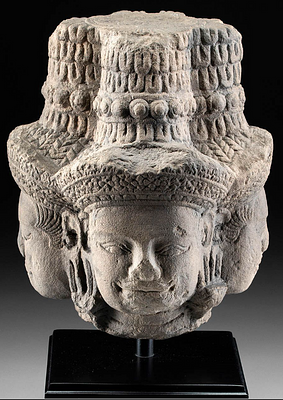Inuit Soapstone Figure Hunter w/ Spear, Joe Talirunili
Lot 121d
About Seller
Artemis Gallery
686 S Taylor Ave, Ste 106
Louisville, CO 80027
United States
Selling antiquities, ancient and ethnographic art online since 1993, Artemis Gallery specializes in Classical Antiquities (Egyptian, Greek, Roman, Near Eastern), Asian, Pre-Columbian, African / Tribal / Oceanographic art. Our extensive inventory includes pottery, stone, metal, wood, glass and textil...Read more
Categories
Estimate:
$4,000 - $6,000
Absentee vs Live bid
Two ways to bid:
- Leave a max absentee bid and the platform will bid on your behalf up to your maximum bid during the live auction.
- Bid live during the auction and your bids will be submitted real-time to the auctioneer.
Bid Increments
| Price | Bid Increment |
|---|---|
| $0 | $25 |
| $300 | $50 |
| $1,000 | $100 |
| $2,000 | $250 |
| $5,000 | $500 |
| $10,000 | $1,000 |
| $20,000 | $2,500 |
| $50,000 | $5,000 |
| $100,000 | $10,000 |
| $200,000 | $20,000 |
About Auction
By Artemis Gallery
Jun 29, 2023
Set Reminder
2023-06-29 10:00:00
2023-06-29 10:00:00
America/New_York
Bidsquare
Bidsquare : Exceptional Antiquities, Ethnographic and Fine Art
https://www.bidsquare.com/auctions/artemis-gallery/exceptional-antiquities-ethnographic-and-fine-art-13031
Artemis Gallery info@artemisgallery.com
Artemis Gallery info@artemisgallery.com
- Lot Description
Joe Talirunili (Inuit, 1893-1976). Hunter with Harpoon and Spear. Soapstone sculpture with wood and walrus ivory, ca. 1960s to 1970s. Signed in English on underside of right foot. An enticing soapstone sculpture by renowned Inuit printmaker and sculptor Joe Talirunili depicting a hunter carrying weapons of wood and walrus ivory. A characteristically veristic portrayal of everyday life in the arctic, Talirunili's hunter stands atop slightly bent legs and tall boots, draped in a knee-length hooded coat with a thick collar as he holds a wood and thread toggling harpoon upright in one hand and a wood fishing gaff with an ivory hook in the other. His minimalist visage is comprised of huge, wide eyes - reminiscent of Talirunili's famed owl sculptures - as well as a broad nose, and straight mouth, all crowned by a hemispherical coiffure. Though relatively simplistic in form, short dashes add texture to his hair, while a fringe lines the lower hem of his coat. Size: 3.8" W x 11.6" H (9.7 cm x 29.5 cm)
Born in either 1893, 1899, or 1906, Joe Talirunili was known for his depictions of the harshness of the northern climate and the survivalist lifestyle of a people dependent on a barren landscape, often crudely executed, as though emphasizing the artist's urgency and conviction for documenting his thoughts. The rugged aesthetic Talirunili favored for his sculptures set them apart from the majority of those being produced from Puvirnituq at the time, which were increasingly being recognized for their "idealized, dreamlike quality," smooth surfaces, and fine details. His sculpture "The Migration" made Talirunili one of the most sought after Inuit artists, as it held the world record for a price paid for an Inuit artist at auction in 2012, a record that was only surpassed when Talirunili's "Migration Boat" (early to mid-1970s) sold for $408,000 in 2019. Both sculptures portray one of his childhood experiences, when families set sail in an umiak (large sealskin boat) to travel to better hunting grounds. This scene was repeatedly depicted in Joe's carvings, drawings and prints. Talirunili's work has been included in over 30 exhibitions and was featured on a 14-cent Canadian stamp in 1976.
When speaking of Joe Talirunili in "Canadian Inuit Print Artist/Printer Biographies," Sandra Barz states, "He left a legacy of sculpture, prints and drawings, which were unique in the way he crafted even the most mundane subject. His owls were horned 'Joe' owls, his human figures, animals and hunting scenes were instantly distinguishable, as were the haunting 'migration' boat scenes, whether rendered as drawings, prints or sculptures. Perhaps redundant as identification, but part of his enormous charm, was the inevitable 'JOE' (sometimes backwards) carved into his stones, almost as part of the image. His contributions to editioned print collections started with the initial release in 1962 and continued without a break through the next 10 collections for a total of some 70 stonecut prints. He cut his own stones and probably tried his hand at printing, too, on occasion."
This is an ESA antique exempt piece of ivory and cannot be sold internationally or to anyone residing in the states of California, Hawaii, Illinois, Nevada, New Hampshire, New Jersey, New York, Oregon, and Washington. Parts from certain animal species may require an additional license upon import into another country due to legislation relating to endangered species and environmental conservation. If you are not sure whether CITES rules apply to your item, please see the CITES Appendices.
Provenance: private Greenwood Village, Colorado, USA collection
All items legal to buy/sell under U.S. Statute covering cultural patrimony Code 2600, CHAPTER 14, and are guaranteed to be as described or your money back.
A Certificate of Authenticity will accompany all winning bids.
We ship worldwide and handle all shipping in-house for your convenience.
#178818Professionally repaired with light restoration over break lines, as well as chipping to tip of hood, proper right hand, and nose. Indentations to top of head and nicks and scratches to surface. Otherwise, form is still clear with nice remaining detail and good preservation of wood and ivory weapons. Weapons are removable from sculpture.Condition
- Shipping Info
-
All shipping is handled in-house for your convenience. Your invoice from Artemis Gallery will include shipping calculation instructions. If in doubt, please inquire BEFORE bidding for estimated shipping costs for individual items.
-
- Buyer's Premium



 EUR
EUR CAD
CAD AUD
AUD GBP
GBP MXN
MXN HKD
HKD CNY
CNY MYR
MYR SEK
SEK SGD
SGD CHF
CHF THB
THB















